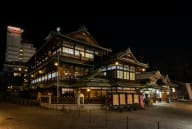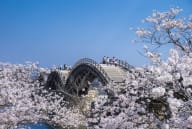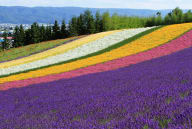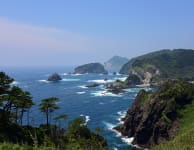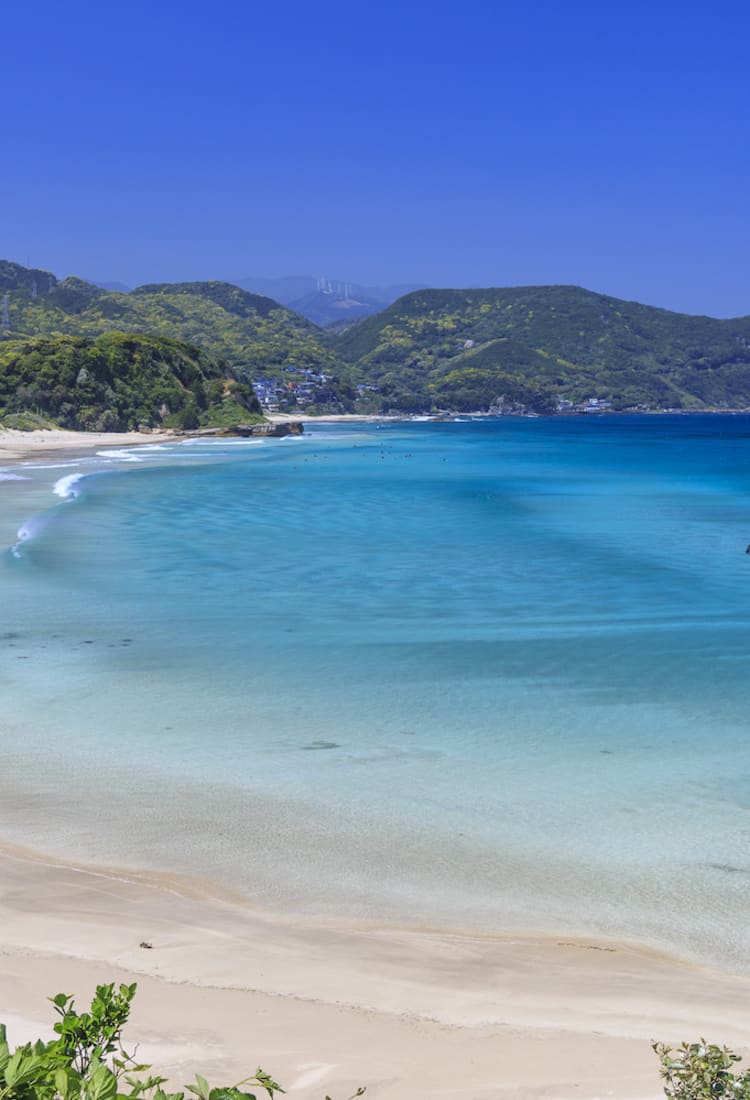

SHIZUOKA Péninsule d'Izu Des spots de surf et des plages de sable de renommée mondiale, des hébergements en montagne, des onsen entourés de nature et un littoral escarpé qui valent le détour
Des spots de surf et des plages de sable de renommée mondiale, des hébergements en montagne, des onsen entourés de nature et un littoral escarpé qui valent le détour
Dans la préfecture de Shizuoka, la péninsule d'Izu est réputée pour ses plages, ses onsen et ses sports nautiques. Elle abrite plusieurs plages très appréciées devenues des institutions, comme Atami, Ito et Shimoda . Les petites villes comme Minami-Izu et Nishi-Izu gagnent également en popularité. La péninsule est dominée par le mont Fuji au nord-ouest et fait partie du parc national de Fuji-Hakone-Izu.
Les montagnes et hauts plateaux d'Izu constituent des atouts majeurs pour les randonneurs et les amoureux de la nature. Au dîner, vous pouvez goûter à des plats à base de sanglier sauvage accompagné de légumes de montagne. La zone a également joué un rôle considérable dans les relations internationales, lorsque le premier consulat général officiel des États-Unis a négocié un traité commercial à cet endroit, mettant fin à la longue période d'isolement japonais par rapport au reste du monde.
À ne pas manquer
- Visiter les grottes de Dogashima à Nishiizu
- Les eaux cristallines et les plages de sable blanc de Shimoda
- Parcourir le littoral d'Izu à bord de l'Ito Line pour des vues spectaculaires
Comment s'y rendre
La région d'Izu se trouve à moins d'une heure de train à grande vitesse de Tokyo.
Au départ de la gare de Tokyo, la JR Tokaido Shinkansen atteint la gare d'Atami, porte d'entrée d'Izu, en 50 minutes. Vous pouvez également prendre le Limited Express Odoriko au départ de Tokyo en direction d'Atami, ainsi que des trains plus lents de la Tokaido Line. Utilisez votre Japan Rail Pass si vous voyager sur les lignes JR.

En commençant votre voyage par l'est
Higashi-Izu compte plusieurs stations thermales, établies de longue date, telles qu'Atami et Ito, vous réservant leur lot d'auberges célèbres et certaines des meilleures sources thermales du pays. L'onsen d'Inatori , connu pour son vivaneau kinmedai et ses poupées hina tsurushi, et l'onsen d'Atagawa, découvert par le samouraï Ota Doukan au XVe siècle, ont depuis permis à de nombreux baigneurs de se détendre. Les ports de pêche de la région offrent certains des fruits de mer les plus frais du Japon.


Des navires noirs aux sables blancs
Shimoda, ville portuaire située à l'extrémité sud de la péninsule d'Izu, est un lieu historique où débarquèrent les navires noirs dirigés par le commodore Matthew Perry, qui commencèrent à commercer avec les États-Unis après une longue période d'isolement. Le temple Ryosenji , où le traité a été signé, se trouve au bout de Perry Road, une agréable promenade dans la ville.
Bien que Shimoda ait une histoire intéressante, la ville est également populaire pour ses nombreuses plages, comme la plage de Shirahama Ohama, offrant certains des meilleurs spots de surf, de sports nautiques et certaines des meilleures plages du Japon. On trouve aussi des chambres d'hôtes en bord de mer, des hôtels et des auberges un peu partout dans Shimoda, certains avec des sources chaudes.


Un littoral escarpé
La pointe sud de la péninsule d'Izu, correspondant au cap Irozaki , offre des paysages marins escarpés, avec un littoral irrégulier et des falaises abruptes. Depuis le phare, vous avez un panorama exceptionnel et vous pouvez monter à bord d'un bateau qui navigue autour du cap.
Direction l'intérieur des terres, sur les hauts plateaux et dans les forêts
À l'intérieur des terres, les paysages naturels d'Izu sont également ravissants, comme les hauts plateaux verdoyants d'Izu et le mont Omuro , un volcan éteint en forme de bol. Le mont Amagi, le point le plus haut d'Izu, est en réalité une série de pics dont l'ascension mérite le détour, notamment pour les monts Banjiro et Banzaburo. Cette zone abrite également la magnifique cascade de Joren-no-Taki, près de champs de wasabi, des endroits propices à la pêche à la truite et l'onsen de Shuzenji .
Si vous êtes la région, visitez l'un de ses nombreux jardins, musées historiques et galeries d'art, avec des œuvres de Renoir et Picasso.
Des îlots fascinants, la baie la plus profonde du Japon et un cap d'or
Le littoral en zigzag de Nishi-Izu est l'un des reliefs les plus fascinants du Japon. La côte de Dogashima qui s'étend de Sebama jusqu'au cap Ajo est parsemée de rochers et d'îlots aux formes curieuses, à l'image de Sanshirojima et de Zojima.
Dogashima Onsen, une station thermale en bord de mer aux innombrables et superbes auberges et hôtels, donne accès à deux phénomènes qui méritent le coup d'œil. Le premier est un tombolo : vous pouvez traverser à pied l'étendue de mer entre le continent et l'île Sanshiro à marée basse. Le second est une grotte marine dotée d'une fenêtre naturelle, à la fois apaisante et mystérieuse.
Plus au nord sur la côte, on trouve Toi et sa mine d'or, ses belles plages et ses propres onsen. La côte ouest d'Izu fait face à la baie de Suruga, l'un des plus grands réservoirs de fruits de mer du pays.Goûtez aux crevettes Red Cherry (ou crevette sakura), une véritable spécialité de la région.


Direction le symbole du Japon, le mont Fuji
Izu est une destination populaire pour une excursion d'une journée au départ de Tokyo, mais il faut au moins plusieurs jours pour pleinement l'apprécier. Si vous restez près d'Atami, pourquoi ne pas se rendre à la montagne la plus emblématique du Japon, le mont Fuji . Il est visible depuis la péninsule d'Izu, mais rien ne vaut le fait de le voir de près.
















